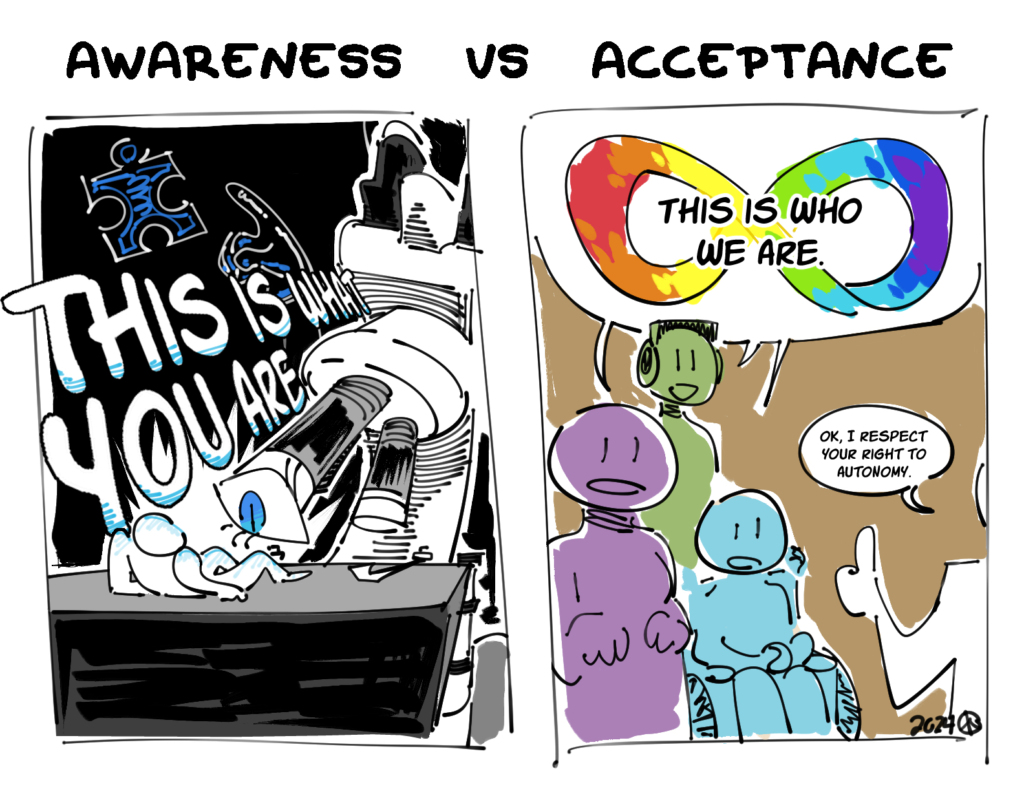For the first time, the White House has issued an official proclamation recognizing April 2 as World Autism Acceptance Day, in contrast to prior years’ proclamations, which have used the term awareness instead of acceptance. This change marks a step towards wider recognition of autistic peoples’ right to self-determination, as the term ‘autism awareness’ is favored by organizations seeking to ‘cure’ autism, rather than the autistic community itself, which by and large favors the term acceptance.
President Joe Biden called upon all Americans to “learn more about autism to improve early diagnosis, to learn more about the experiences of autistic people from autistic people, and to build more welcoming and inclusive communities to support people with autism.”
Advocates have been urging Biden to change the language used in the proclamation since 2021, according to Kim Musheno, vice president of the Autism Society of America.
“We made the switch in 2021. I tried to get the president to switch in the proclamation for the past two years without success until this year,” Musheno told DisabilityScoop.

April 2 was originally declared World Autism Awareness Day by the United Nations General Assembly in 2007. The entire month was later named Autism Awareness Month by the allistic (referring to a lack of autism)-run organization Autism Speaks in their 2010 “Light It Up Blue” campaign.
Autism Speaks has drawn criticism for failing to consult or involve the autistic community in their project, as well as numerous other complaints of harmful behavior. These include AS members comparing autism to diseases and natural disasters, the organization airing a documentary in which a board member expressed her wish to kill her autistic daughter and herself (and subsequent commentary that this sentiment was “not unusual” among parents of autistic children) and the organization’s history of endorsing and funding research for a ‘cure’ to autism.
While commonly associated with children or asocial computer geeks in mainstream media, the reality is autistic people span the gamut from students and activists to professionals of all sorts to people living quietly at home or on the street. The autistic community has its own culture, history and vocabulary used to discuss individuals’ experiences as autistics in a world that is often ignorant of or outright hostile to their needs.
The term allistic was coined in 2003 by Andrew Main in a parody piece meant to resemble a psychology paper. Main’s piece described allism as “a debilitating neurological condition which adversely affects emotional stability, sensory perception, self-awareness, attention, and many other areas of mental function.” Main explained that he intended to draw awareness to the ways allistic people pathologize the behavior of autistic people. “By giving both conditions labels, we can avoid implicitly marking one condition as abnormal,” Main wrote.
This drive for acceptance is the prevailing sentiment among autistic adults, who have taken to organization and activism since the 1990s as a part of the neurodiversity movement. These efforts work to promote a model of disability that focuses on how society fails to support affected individuals rather than on a perceived failing of normalcy within the individual itself.
In reaction to allistic-run groups such as Autism Speaks which have focused on finding a way to ‘cure’ autism or eliminate it from the gene pool, autistic people have formed their own organizations to speak for themselves. One such group is the Autistic Self-Advocacy Network (ASAN) which was founded in 2006 and has since then lobbied for increases in minimum wage, disability rights and maintaining clear and accurate diagnostic criteria for autism in the DSM-V.
One of the most foundational texts of the autism rights movement comes from a speech and subsequent essay by autistic activist Jim Sinclair at the 1993 International Conference on Autism in Toronto, in which Sinclair challenges parents and other community members to change the way they view autism.
“Autism is a way of being. It is not possible to separate the person from the autism. Therefore, when parents say, ‘I wish my child did not have autism,’ what they’re really saying is, ‘I wish the autistic child I have did not exist, and I had a different (non-autistic) child instead,’” Sinclair wrote in xer 1993 essay, “Don’t Mourn For Us.”
“Yes, there is tragedy that comes with autism: not because of what we are, but because of the things that happen to us. … The tragedy is not that we’re here, but that your world has no place for us to be. How can it be otherwise, as long as our own parents are still grieving over having brought us into the world?
“We need and deserve families who can see us and value us for ourselves, not families whose vision of us is obscured by the ghosts of children who never lived. Grieve if you must, for your own lost dreams. But don’t mourn for us. We are alive. We are real. And we’re here waiting for you.”


